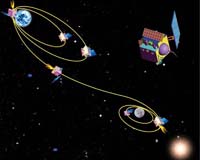The "Indian Space Research Organization" (Indian Space Research Organization or ISRO for short), which is under government control, is trying to lead India towards the prestigious club of countries that have sent an expedition to the moon

The Indian capability in space science gets a new boost when the US shows a strong desire to place a payload on the first Indian spacecraft to the moon - Chandrayaan 1.
Many believe that the American desire to place a cargo in the first Indian spacecraft to the moon is a marriage proposal between the two countries and the move is defined as a change in Washington's attitude towards the Indian space program. During the Cold War years, India and the US were on different sides of a screen and India tied together its missile program, space program and nuclear program against Pakistan and China.
The "Indian Space Research Organization" (Indian Space Research Organization or ISRO for short), which is under government control, is trying to lead India towards the prestigious club of countries that have sent an expedition to the moon. The desire of the program managers is to send robots to space and the moon and at the next stage to carry out more ambitious projects such as sending Indian research spacecraft to other planets in the solar system. Also, the organization intends to launch India's first operational commercial satellite in April-May.
India's unmanned space mission was approved in 2004 and received high priority among decision makers in India following the success of the Chinese space program in the manned launch of the first Chinese technaut Yang Li-wai in October 2003 aboard the Shenzhou 5 and later with the successful launch of two more technauts in October 2005 On top of the Shenzhou 6.
India began its space program in 1963 by launching a 9 kg rocket into space. And since then it has progressed in two main directions, one for the design and construction of spacecraft to explore the Earth and the other direction for the study of the solar system and its stars. The "Chandrian 1" spacecraft is a leap forward for the country, it is supposed to take off into space in 2007-2008 at a total cost of 80 million dollars and its purpose is to explore the surface of the moon as well as map it to create a three-dimensional atlas of its territory.
US-India relations continue to heat up and cooperation in the space program continues a trend of warming relations between the two countries that has already been manifested in areas such as nuclear energy and strategic cooperation in the Indian subcontinent. It seems that the US has decided to stop watching every mission of India through a magnifying glass and instead cooperate so that both sides benefit.
The science system adds that, as you remember, the Israeli Minister of Science at the time, Modi Zandberg, signed an agreement with India according to which Israeli scientists will also be able to install systems on the Indian spacecraft that will fly to the moon.
